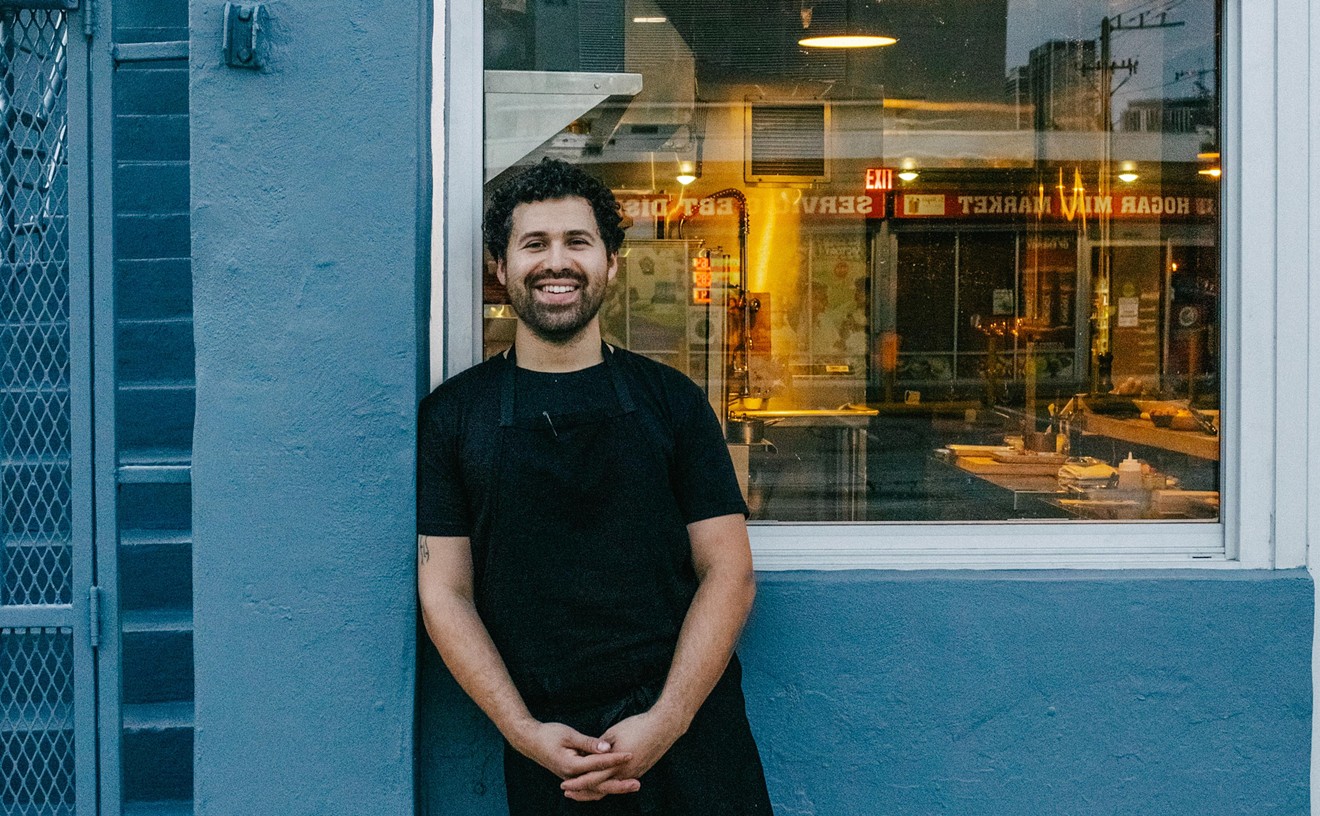Then again, Ideas Restaurant has some issues too. Like location, location, location: It's between a Flanigan's and a Pizza Hut, in the quaint, two-story house that has in recent years served as a sort of morgue for Italian restaurants (Il Tulipano bloomed here for a shorter time than a tulip). Worse: This is Coconut Grove, which is to upscale dining establishments what the Spanish Inquisition was to Jews.
Idea's second-worst idea: handing out a full-page menu of nightly specials written in Spanish only. I suppose this encourages dialogue between the diners and waitstaff, who discuss the cuisine with knowledge and enthusiasm — although some are barely more fluent in English than the menu. This puts non-Spanish-speaking diners at a real disadvantage. It's one thing to ask your server to interpret one, two, or three items, but most folks will be too intimidated to request a full translation of some two dozen specials (though weeknights mercifully bring a much shorter list). Our waiter explained that many of the dishes are tapas-size, and encouraged us to order a whole bunch and share, but there were no prices printed either. And again, nobody will feel comfortable saying, "How much does this cost? And this? And this? And this? And this? And this?..."
Don't ask Chef Alvaro Beade for language help. He arrived here from his home in Valladolid, Spain, just before Ideas opened its doors about three months ago, and hardly speaks English. You can watch him and his kitchen crew (composed of extern students from Le Cordon Bleu) at work in a gleaming stainless-steel kitchen through a large picture window in the restaurant (the left side of the 60-seat room lends the best sight lines). Although the gastronomic goings-on form the visual focal point, the rest of the tastefully appointed space is really quite lovely — bathed in beige, gracefully draped, and soothingly illuminated.
Idea's cuisine, like its chef, hails from Castilla y León, of which Valladolid is the capital. Many of the foodstuffs are imported from this region as well, like pan lechugino, a triangle cut from an embossed, golden-crusted round of dense white bread. Mediterranean seafoods are flown in, too, including calamarilike cuttlefish, lubina (sea bass), and dorada (sea bream), a small fish with tender flesh and a succulent, meaty flavor somewhat similar to pompano. Here it comes in a sea salt crust, a favorite Spanish preparation, but Beade breaks with two traditions: There is no tableside cracking-of-the-crust ceremony — it is performed in the kitchen. And instead of the whole, skin-on dorada getting salted, each cleaned fillet is coated, which lent the fish an unfortunately salty flavor. A purée of Peruvian purple potato on the side was sumptuously delicious, and smatterings of fresh tomato-shallot concassé were also tasty, but this fish would have benefited from some sort of emulsion sauce.
Some other dishes are likewise presented in simple, unadorned fashion, but most of the time the foods get what little they need. For instance, an order of "fried" littleneck clams, which are actually pan-fried with garlic, herbs, and white wine, came plunked plainly into a white bowl, but how perfectly plump, saline, and satisfying they were. Nothing much fancy about an appetizer trio of tapered, roasted piquillo peppers either, except the piquillo peppers — sweet, slightly piquant, and grown only in the Ebro River Valley of Northern Spain. Beade fills each pepper with a velvety purée of bacalao and then drizzles piquillo-cognac sauce across the top.
Veal cheeks have been gaining currency on national restaurant menus (though not many local ones). They are meltingly tender because the collagen embedded in them turns to gelatin during cooking, which creates a natural beefy, self-basting glaze (the same thing happens with oxtails and osso buco, although cheeks are unique in that they don't rely on bones). Here the knobs of veal are darkly braised in red wine, topped with asparagus spears ever-so-lightly battered and fried, and sided by a smidgen of luscious baby lima beans dotted with bits of Serrano ham. Bouncy baby lamb chops will appeal to more conventional carnivores, as surely will the 35-ounce, $68 bone-in rib eye — which is for two people, but an unusually large cut nonetheless. The regular menu, incidentally, does come with prices (as well as translations). Entrées range from $28 to $36.
Ideas has been open since only late October, which isn't enough time to honestly declare a signature dish, but I hereby nominate the suckling baby pig. At first it looked as though the large leg arriving on the plate were cold, but as soon as the fork cracked the crackly crust, a plume of steam shot out as if from the smokestack of a locomotive (well, almost). The juicy little pig is generously spiced, slowly simmered in its fat for three hours, and then finished in the oven; a dense, scrumptiously cheesy square of Yukon Gold potato gratin leans alongside.
For the anti-signature dish, I'd go, or more accurately not go, with potato soup. The flavor was fine — the gray-white purée dotted with wild mushrooms (too teeny to identify) and chorizo, drizzled with that sausage's oil, and finished with a welcome touch of nutmeg. The consistency, though, was so gluey I feared that if I were to let it linger in the mouth too long, my teeth would be forever fused together. Hard to believe the same kitchen dished out an amuse-bouchée featuring an impossibly smooth puréed lentil soup with a miniature quenelle of cheese mousse and a crinkly bite of Serrano ham. On another visit, we were greeted with a tasty triangular empanada enveloping a moist mussel. My dinner mate, who refrains from eating shellfish, was brought instead a small fluted glass of first-class gazpacho.
Although Beade doesn't dabble in molecular science or deconstructionism, he places a confident, contemporary spin on traditional Spanish cooking. This is especially true of desserts, one of the best being a nightly special that brought a dense coconut flan topped with a scoop of electric ginger granitas, a smear of rich coconut cream, and a clear cube of gelatinized rum. Hoo-boy. And hoo-ray for the service, which, excepting occasional linguistic lapses, was excellent. Restaurant manager Aniece Meinhold orchestrates the staff as a consummate pro would; if you need to know anything (and you likely will), she's the one to ask. Meinhold is likewise wine-savvy, and the list here is laden with major Leonese labels, most notably the fruity Verdejo whites of Rueda and rousing reds from Ribera del Duero (and from Toro too).
You might want to check out Ideas soon. This being Coconut Grove, you never know how long an upscale notion will last.










